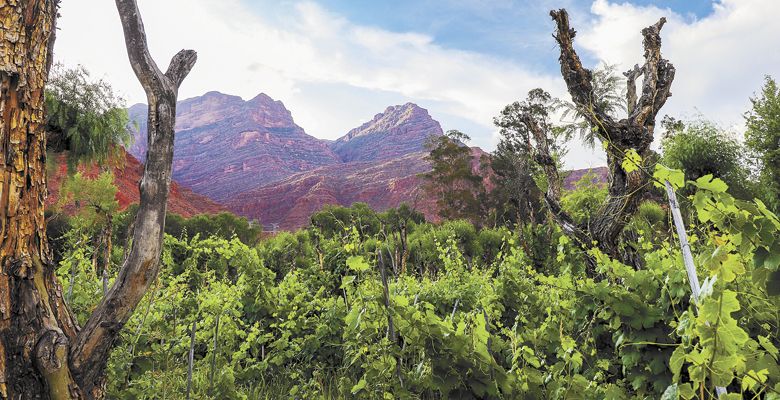Extreme-Altitude Endeavor
Portland importer elevates Bolivian producers
When most people consider South American wine, they think of chewy, steak-friendly reds like Tannat and Malbec. Maybe even a Sauvignon Blanc from Chile or a Torrontes from Argentina. But what of Bolivian Vischoqueña?
Darren Armstrong intends to bring the work of one of the least-known wine regions in the world to the front of your local bottle shop, at least in the form of a few under-the-radar labels. The South American nation is known more for devil dances during carnival, sky-high capital cities and the seemingly infinite Lake Titicaca. Increasingly though, while on a relatively small scale, Bolivia is working to expand its wine footprint.
Armstrong works for Chufly Imports; its main objective is to introduce the U.S. to Bolivian wines and singani, an indigenous brandy. He represents labels like Aranjuez and 1750 Wine in Portland and the greater Northwest, traveling to Bolivia at least once a year to check in on the industry. Chufly services a handful of other states and just brought on another Bolivian wine label in La Concepción. The eye-catching brand features traditional Bolivian color schemes with a production model focused on noble varieties like Syrah and Cabernet Sauvignon.
Last October, Armstrong hosted a small group of industry types at Casa Zoraya in North Portland. For an evening, the Peruvian kitchen team played the roles of Bolivian hosts, cooking hearty, traditional dishes like pork belly chicharrones with mote (giant South American corn) and sweet potato. Wines made from Torrontes Moscatel, Tannat and Merlot accompanied the meal, showing well and standing up to the comforting fare.
The Torrontes, produced by Aranjuez, was especially bright and lively, with a round, jasmine-driven nose. The Aranjuez DUO blend of Tannat and Merlot — 50-50 — also a star, showing refined red fruit and a balanced structure. The wines appeared to reflect their high-altitude origin, with a pleasant acidic streak suggesting significant diurnal shifts in the vineyard. The whites especially should appeal to fans of heightened aromatics.
The quality of Bolivian wines, Armstrong says, has progressed significantly. He admits to much inconsistency early on, but there’s greater focus and personality in what’s being produced today. “La Paz’s booming food scene has helped smaller producers, giving them a place to showcase their products in quality restaurants that want to show something unique,” he adds. “This is pushing them to increase quality without sacrificing heritage.”
Armstrong, quite familiar with that scene, worked on the wine list at acclaimed La Paz restaurant Gustu. The acclaimed eatery focuses entirely on local ingredients, including wine. Its “zero kilometer” philosophy means all products used in their drinks and dishes are sourced fully from Bolivian producers.
An inconsistent local wine scene made for challenging menu placements, but after a while, Armstrong began to meet with winemakers and get an understanding of the craft and focus on the best of the bunch. He spent three years in the country, gaining perspective on its winemaking ways.
Presently, the majority of what’s produced remains within Bolivia’s borders. Framed by towering mountain ranges, regions like the Cinti, Santa Cruz and Tarija valleys are growing wine at some of the highest altitudes imaginable. Many vineyards gulp cool mountain air at a mile, or so, above sea level. According to GuildSomm, a staggering 99 percent of plantings exist at 5,200 feet or higher, precisely why they’re frequently referred to as “vinos de altura.”
While wine has been produced in Bolivia for almost 500 years, it’s a history soaked in geographic isolation and vying interests. The country is notoriously landlocked, fenced-in by natural mountain peaks known to crest 20,000 feet. For years, natural resource exploration — namely mining — was preferred to planting grapes, especially at high altitude, with the possibility of extreme temperatures.
The Spanish introduced grapes like Moscatel in the 16th century. “Negra mollina” was often trained up molle trees, an Andean native often referred to as a pink peppercorn tree. Signani was the focus for centuries, distilled to satisfy thirsty silver miners and warm the bones of Bolivians mid-winter.
The modern wine movement really began in the 1960s when wine technologies from Argentina made their way into Tarija. More and more wines experienced the stability of temperature-controlled tanks and ferments. Soon, more affordable, locally grown wines became available. By the early 1990s, the valleys of Tarija and Cinti, along with La Paz and Potosí, were recognized appellations. The lattermost location — Spanish for “rich mountain” — was a mining stronghold and is home to vines estimated to be three centuries old.
Armstrong and his team are currently investigating Vicchoqueña, quite possibly the most fun-to-pronounce grape variety in existence. “It’s almost like a red Muscat that has a Pinot Noir-like elegance with the Muscat aroma,” he says. “It’s crazy and completely unique to the Cinti Valley region.
“I’m excited for the potential of Bolivia’s terroir,” Armstrong adds. Because the nation is far closer to the equator than most wine-producing areas, he believes opportunity exists for experimentation. Familiar European varietals like Tannat, Cab Franc, Petit Verdot and Marselan could, at least in theory, show even more personality when exposed to the high mountain air and dramatic temperature swings of the Bolivian valleys.
“There’s still a lot of research to do,” Armstrong admits. “Lots of stories in those mountains.”











